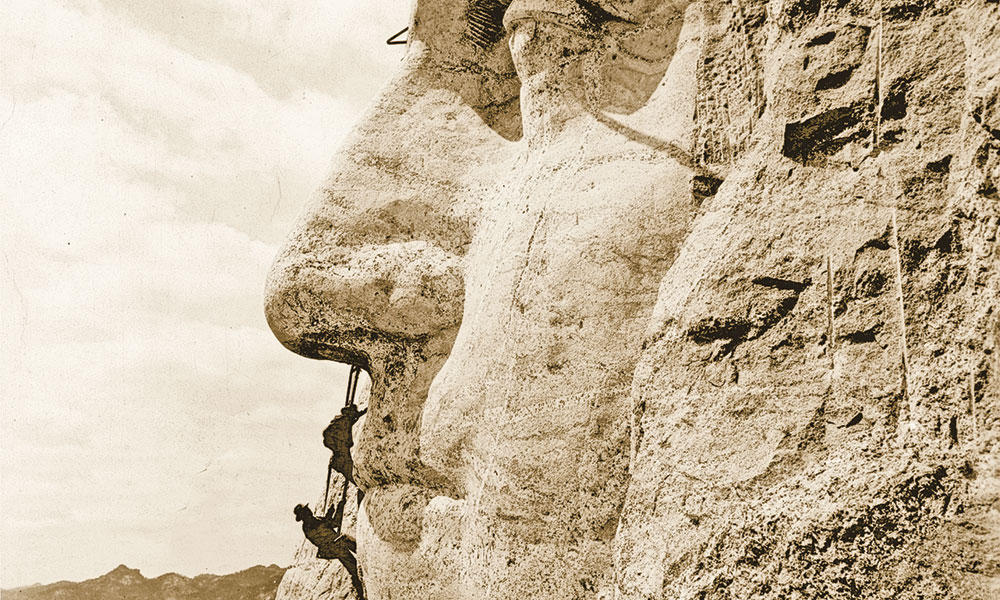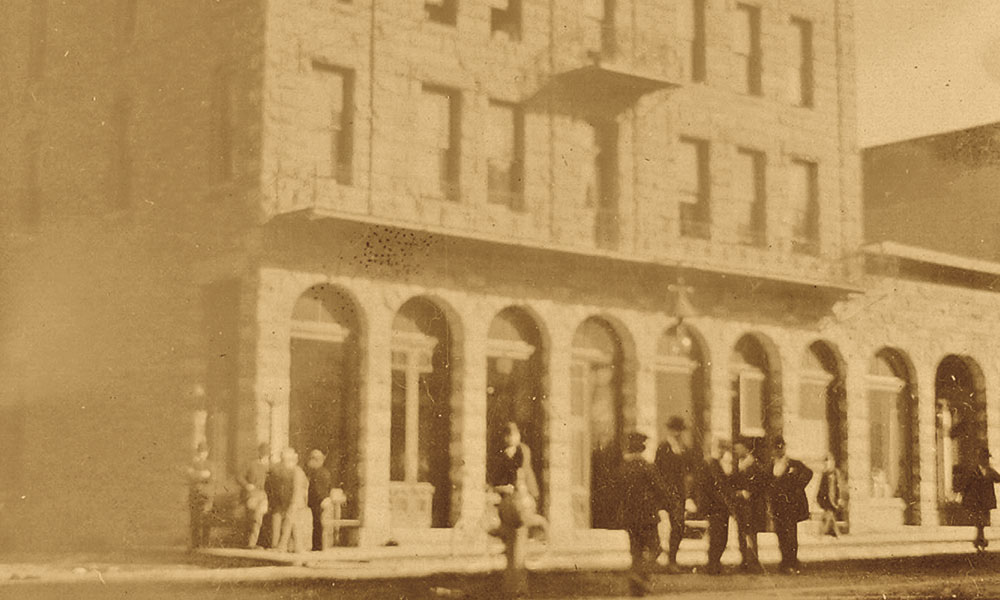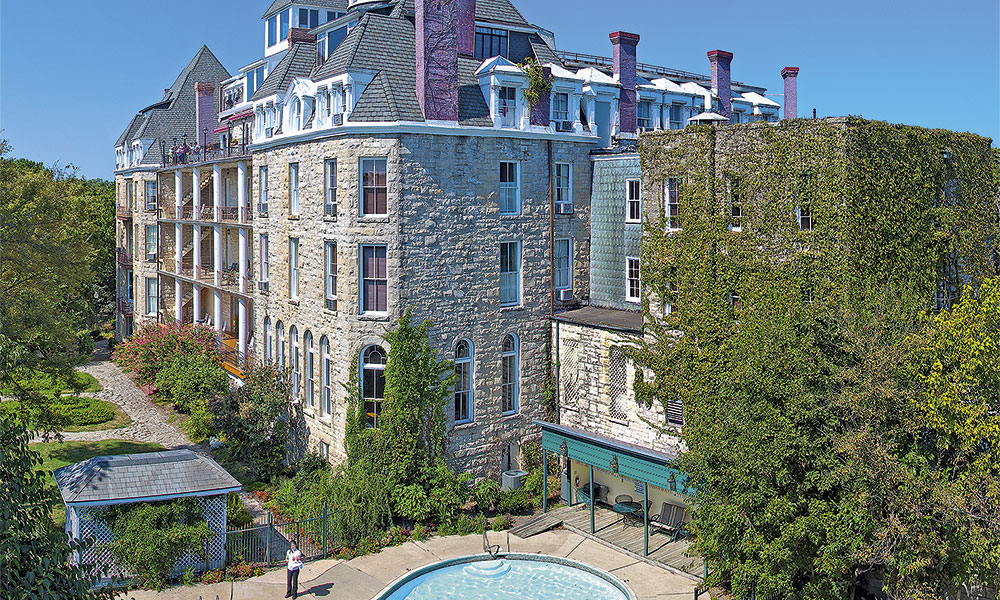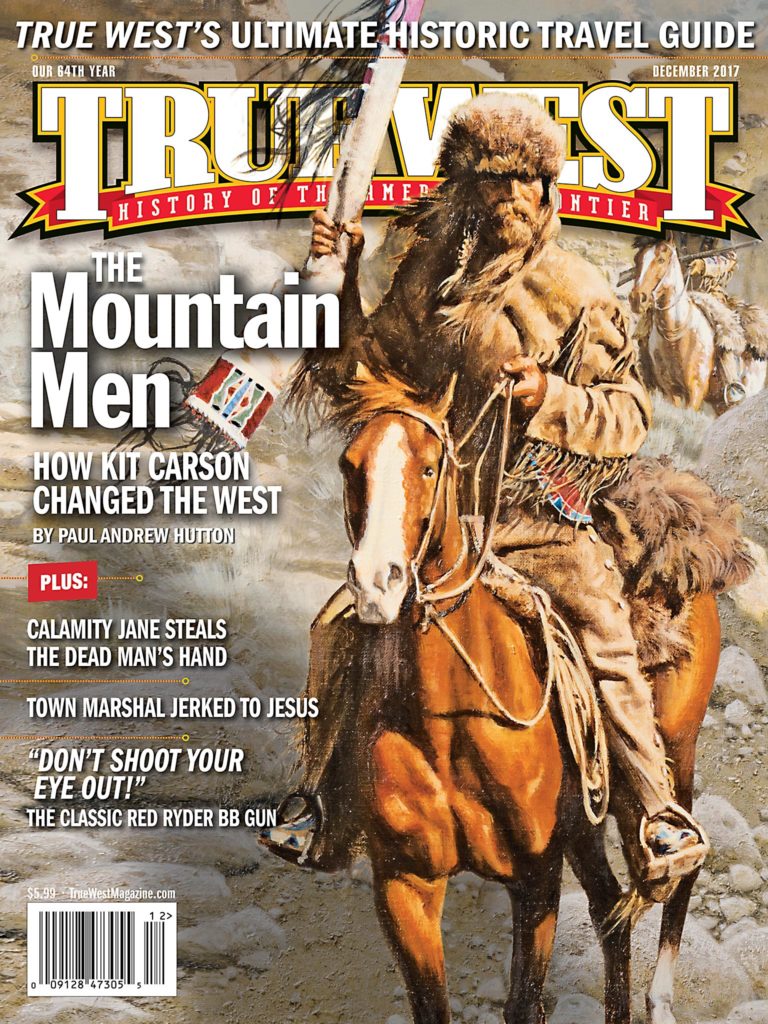
— Library of Congress —
The Northern Prairies and Plains of the West are awe-inspiring in their natural beauty, endless vistas, rolling hills, dense forests and long, winding river valleys.
Today, millions of acres of land are planted with grains that feed a world, where tens of millions of bison once roamed and nomadic Indian tribes followed with the seasons.
From the legendary shores of Minnesota’s Lake Superior to the mystical Black Hills of South Dakota, from the banks of the Mississippi where William F. Cody was born in the Iowa Territory to the historic earthen lodge Indian villages of North Dakota, visitors to the Northern Prairie and Plains will discover a region rich in history, culture and heritage.
Iowa
Buffalo Bill Museum
The Mississippi River town of LeClaire has a rich Western heritage, including being the birthplace of William F. “Buffalo Bill” Cody on February 26, 1846.
The Buffalo Bill Museum has a broad collection that celebrates the region’s history, and the LeClaire’s Famous Sons exhibit.
After visiting LeClaire, take a short drive to tour the Buffalo Bill Cody Homestead in Scott County.
200 N Cody Rd, Le Claire, IA 52753 • 563-289-5580 BuffaloBillMuseumLeClaire.com/ ScottCountyIowa.Com
The Fort Museum & Frontier Village
In May 1850, a U.S. soldiers were sent from Minnesota to build a fort on the Des Moines River in Iowa.
Fort Dodge was named in honor of Wisconsin Senator Col. Henry Dodge, who in 1833 had founded the 1st U.S. Dragoons. The fort was sold to the post sutler William Williams in 1853, who then plated out the town of Fort Dodge.
The Fort Museum & Frontier Village is an interactive history center that honors the town’s role in the settlement of Iowa.
614 9th St, Fort Madison, IA 52627
515-573-4231 • FortMuseum.com
John Wayne Birthplace & Museum
On May 27, 1907, Marion Robert Morrison was born in Winterset, the son of Clyde and Mary Brown Morrison. The Iowan from Madison County would grow up to be film star John Wayne.
Today, the John Wayne Birthplace & Museum is a destination for the iconic Westerner’s fans worldwide.
Tour the museum just off Winterset’s historic town square which was dedicated in 2015, his humble childhood home, and plan on attending the museum’s biggest annual event—the two-day John Wayne Birthday Celebration held every May.
205 John Wayne Dr, Winterset, IA 50273
877-462-1044 • JohnWayneBirthplace.museum
Golden Spike Monument
In 1862 Congress determined that the Union Pacific Railroad Company would start construction on the eastern shore of the Missouri River in Council Bluffs.
In 1939, as a promotion for the film Union Pacific, the 56-foot Golden Spike Monument was dedicated in Council Bluffs at Mile Marker Zero of the rail line.
When in Council Bluffs, don’t miss the Historic General Dodge House, the Lincoln Monument, the Union Pacific Railroad Museum and the Western Historic Trails Center.
2073-2099 9th Ave, Council Bluffs, IA 51501
712-256-257 • TravelCouncilBluffs.com
Old Fort Madison
Fort Madison was built along the Mississippi River in 1808, 38 years before Iowa was a state.
An outpost until 1813, it is the oldest American fort on the Upper Mississippi, and was attacked by the British during the War of 1812.
Old Fort Madison provides an extraordinary historical interpretation of the earliest decades of American trans-Appalachian history, including annual re-enactment events.
614 9th St, Fort Madison, IA 52627
319-372-6318 • FortMadison.com
Sergeant Floyd Monument
Sgt. Charles Floyd was the only member of the Corps of Discovery to die on the Lewis and Clark expedition. He died of appendicitis on August 20, 1804, and was buried on a bluff near the river.
The Sergeant Floyd Monument, a 100-foot Egyptian-style obelisk above the Missouri River, was dedicated in his honor in 1901.
2601 S Lewis Blvd, Sioux City, IA 51103
800-593-222 • VisitSiouxCity.org / NPS.gov
Wyatt Earp Home
The Wyatt Earp Home-Van Spanckeren House is home to the Pella Historical Museum Village, dedicated to the history of the 800 Dutch settlers who founded Pella in 1846.
The house’s first-floor apartment was also the childhood home of Wyatt Earp in the early 1860s.
Visitors to the museum will learn what life was like for the Earps, who twice lived in Pella between 1849 and 1864.
507 Franklin St, Pella, IA 50219 • 641-628-2409
PellaHistoricalMuseum.wordpress.com
Minnesota
Fort Ridgely State Park
Built in 1855 adjacent to the Dakota Sioux Reservation in the Minnesota River Valley, Fort Ridgely played a key role in the U.S.-Dakota War of 1862.
Ten years after the war the fort was shuttered and sold. In 1896 a war memorial was built on the site, and in 1911 the state bought the property for a park.
Start at the visitor’s center and tour the interpretive exhibit, which requires a small entrance fee.
72158 County Rd 30, Fairfax, MN 55332
507-426-7840 • DNR.State.MN.us
Grand Portage National Monument
Grand Portage National Monument is co-managed with the Minnesota Chippewa Tribe-Grand Portage Band, and is the most important national park living history center dedicated to the Old Northwest Euro-American fur trade network.
Tours should begin at the visitors center and proceed to the re-created fort on the shore of Lake Superior.
Grand Portage’s signature annual event is the Rendezvous Days and Powwow staged the second week of every August.
Grand Portage, MN 55605 • 218-475-0123 • NPS.gov
James J. Hill House
The James J. Hill House in St. Paul was the largest and most expensive ever built in Minnesota when it was completed in 1891.
The Gilded Age mansion remained the railroad baron’s family home until 1925 when his heirs donated it to the Catholic Diocese.
The Minnesota Historical Society has owned and managed it as a museum since 1978 and it’s now a National Historic Landmark.
240 Summit Ave, St. Paul, MN 55102
651-297-2555 • Sites.MNSH.org
Historic Fort Snelling
Historic Fort Snelling brings history to life at the Army outpost first built in 1825. Located at the confluence of the Minnesota and Mississippi rivers, the U.S. built the outpost to keep the peace in the rich fur trading region of the Upper Mississippi River Valley.
Visitors today enjoy touring the exhibits, attending special history programs and walking the grounds of the fort that served the Army until 1946.
200 Tower Ave, St Paul, MN 55111
612-726-1171 • HistoricFortSnelling.org
Madelia
Following the failed robbery of the First National Bank in Northfield on September 7, 1876, the James-Younger Gang fled southwest and then split up in an attempt to escape being brought to justice.
Two weeks and a 100 miles later, on September 21, 1876, Charlie Pitts and Cole, Jim and Bob Younger were cornered in Hanska Slough outside of Madelia.
Each year during the third week of September, the town of Madelia holds a re-enactment of the Younger Brothers’ Capture that celebrates the townspeople’s role in the enthralling saga of the failed Northfield Bank Robbery.
127 W Main St, Madelia, MN 50602
507-642-8822 • MadeliaMN.com
North West Company Fur Post
Near Pine City, the Minnesota Historical Society’s North West Company Fur Post brings history alive at the reconstructed 1804 trading center.
A museum dedicated to the French voyageur and British fur trade era presents extraordinary exhibits while rangers dressed in period costume conduct educational history programs.
A heritage trail on the Snake River is open throughout the year for recreation.
12551 Voyageur Ln, Pine City, MN 55063
320-629-6356 • Sites.MNHS.org
Northfield Historic District
Founded in 1855, Northfield entered the history books permanently as the legendary site of the James-Younger Gang’s failed robbery of the First National Bank on September 7, 1876.
Visitors to Northfield should tour the historic downtown after touring Northfield’s Historical Society and Museum, in the restored original bank building.
The annual Defeat of Jesse James Days is held every Labor Day Weekend and is one of the premiere Old West re-enactment events in the region.
Northfield Area Chamber of Commerce
205 Third St West, Suite B, Northfield, MN 55057 507-645-5604
VisitingNorthfield.com / NorthfieldHistory.org
Pipestone National Monument
For 3,000 years, the American Indian stone quarry at Pipestone National Monument has been actively used for making pipes.
A monument since 1937, the quarry was saved by the Yankton Sioux tribe of South Dakota and can be used by members of federally recognized American Indian tribes.
Tour the visitors center, watch Native pipestone carving demonstrations and walk the Circle Trail to see the most important features of the park.
36 Reservation Ave, Pipestone, MN 56164
507-825-5464 • NPS.gov
North Dakota
Camp Hancock State Historic Site
Visitors to North Dakota’s state capital, Bismarck, should visit Camp Hancock State Historic Site, dedicated to interpreting local history at the military encampment built to protect the construction crews of the Northern Pacific Railroad in 1872.
101 E Main Ave, Bismarck, ND 58501
701-328-2666 • History.ND.gov
Fort Abercrombie State Historic Site
Nicknamed “the Gateway to the Dakotas,” Fort Ambercrombie was the first American fort built in the Dakota Territory in 1858.
During the U.S.-Dakota War of 1862, the post was under siege for six weeks. Abandoned in 1877, the fort was reconstructed in the 1930s to be an interactive history center, with programs held throughout the year, with most taking place during the summer months.
935 Broadway, Abercrombie, ND 58001
701-553-8513 • History.ND.gov
Fort Buford State Historic Site
Near the confluence of the Yellowstone and Missouri rivers, Fort Buford was constructed in 1866 as a key Army supply depot to support the Northern Plains campaigns.
In service for 29 years, Fort Buford is best known as the 1881 surrender site of Sitting Bull.
Across the Missouri River from Fort Union Trading Post National Historic Site, Fort Buford offers visitors an opportunity to walk into the past of frontier North Dakota.
15349 39th Ln NW, Williston, ND 58801
701-572-9034 • History.ND.gov
Fort Totten State Historic Site
On the banks of Devils Lake, Fort Totten State Historic Site stands as a testament to frontier, military and Indian life in the Dakota Territory after the Civil War.
Built in 1868-’73 as a key outpost adjacent to the Devils Lake Sioux Reservation, the fort was converted to an Indian school in 1890.
Visitors can tour many of the original buildings, including the commissary storehouse, which houses the Fort Totten Interpretive Center.
SE edge of Fort Totten, ND, 13 miles SE of
Devils Lake • 701-328-2666 • History.ND.gov
Fort Union Trading Post National Historic Site
A major living history center along the Lewis and Clark National Historic Trail, Fort Union Trading Post was built in 1826 at the confluence of the Missouri and Yellowstone rivers.
An international trading center, Fort Union was a crossroads of history for four decades, serving most of the famed mountain men and Indian tribes of the era.
Every summer the park hosts events with re-enactors in period dress, including the Fort Union Rendezvous.
15550 Hwy 1804, Williston, ND 58801
701-572-9083 • NPS.gov
Gingras Trading Post State Historic Site
Near Walhalla in northeastern North Dakota near the Manitoba border, Gingras Trading Post State Historic Site interprets and preserves Antoine Blanc Gingras’s 1840s trading post and home.
A Métis fur trader, his restored two-story post and separate home are rare examples of early settlements in the state.
Visitors will enjoy the museum in the finely appointed home, and souvenirs of the fur trade can be purchased in the Gingras store.
12882 129th Ave NE, Walhalla, ND 58282
701-549-2775 • History.ND.gov
Knife River Indian Villages National Historic Site
For 500 years, the Knife River Indian Villages were the traditional home of the Hidatsa people, and later the Mandan and Arikira. They were a major Native tribal trading center on the Missouri River for centuries before the arrival of Europeans.
In the 1750s a fur trading center was established. Tour the visitors center to learn about the role of the Upper Missouri tribes in North American history.
Trails lead from the headquarters to culturally important and fragile village sites preserved in the park.
564 County Rd 37, Stanton, ND 58571
701-745-3300 • NPS.gov
Medora and Theodore Roosevelt National Park
Among the most beautiful—and entertaining—places in North Dakota are the inexorably connected restored historic village of Medora and Theodore Roosevelt National Park.
Every summer the town of Medora comes alive as the community celebrates the legacy of Theodore Roosevelt at the Medora Musical.
Frenchman Marquis de Mores founded the town in 1883 and named it for his wife. The Marquis’s settlement also attracted another New Yorker, Teddy Roosevelt, who built a cattle ranch nearby in 1883.
Roosevelt’s experiences in the Dakota Territory would forever shape his life and political career, and the adjacent national park encompasses the land he so loved.
There are three units to the park: North (near Watford City), Elkhorn Ranch (Roosevelt’s ranch), and South (adjacent to Medora).
The south unit’s scenic drive, many pullouts and trails provide visitors a beautiful overview of the park and opportunities to see wildlife, including bison.
330 Pacific Ave, Medora 58645
701-623-4830 • MedoraND.com / NPS.gov
South Dakota
Badlands National Park
The wild, windswept Badlands National Park is 244,000 acres of buttes and ridgelines that have eroded over millions of years. Enjoy the Badlands Loop Road, with its pullouts, interpretive signs, endless vistas and wildlife.
Stop at the Ben Reifel Visitor Center to learn the story of the Badlands and stay at the Cedar Pass Lodge.
Want to visit the neighboring Pine Ridge Reservation? Stop at the White River Visitor Center, which is staffed by the Oglala Sioux Parks and Recreation Authority.
25214 Ben Reifel Pl, Interior, SD 57750
605-433-5361 • NPS.gov
Black Hills
Legendary and sacred, the Black Hills of western South Dakota remain as magnificent as they are mysterious, a premier Old West destination with thousands of years of history, innumerable trails to follow deep into its wild mountains and home to four of the most significant sites in the West: Custer State Park, Crazy Horse Memorial, Mt. Rushmore National Memorial and Wind Cave National Park.
Whether you camp, stay at a historic lodge, guest ranch or inn, a visit to the Black Hills will inspire the Western traveler to come back many times to see the bison herd in Custer State Park, gaze upon the visages carved in granite at Mt. Rushmore and Crazy Horse, and walk deep in the sacred earth at Wind River Cave.
1851 Discovery Cir, Rapid City, SD 57701
605-355-3700 • BlackHillsBadlands.com
Deadwood and Lead
The epicenter of the Gold Rush of 1874-’76 that transformed the Black Hills, Deadwood was founded to supply the rush of miners everything they needed to survive: supplies, saloons and soiled doves.
Visitors who walk the streets of Deadwood today should start at the visitors center in the restored railroad station for a map of the city, directions to local museums, daily events, historic sites and the Mt. Moriah Cemetery, where Wild Bill Hickok and Calamity Jane are buried side by side.
After touring Deadwood, drive up the mountain to tour the historic gold mining town of Lead.
501 Main St, Deadwood, SD 57732 • 800-344-8826
160 W Main St, Lead, SD 57754 • 605-584-1100
Deadwood.com / LeadMeThere.org
Devil’s Gulch Park
On September 7, 1876, the James-Younger Gang was thwarted in their attempt to rob the First National Bank in Northfield, Minnesota. With multiple posses chasing them west out of Minnesota, the gang split up.
Legend has it that soon after crossing into South Dakota, near Garretson, Jesse was separated from Frank, and while pursued, he avoided capture by leaping the 20-foot chasm of Devil’s Gulch.
5th St & North Central Ave, Garretson, SD 57030
VisitGarretson.com
Fort Pierre Chouteau Site
In the 1830s, the American Fur Company had Frenchman Pierre Chouteau build a fort to serve the region, quickly becoming one of the most important trading posts on the Upper Missouri.
After visiting the Fort Pierre Choteau Site, tour the Vérendrye Museum and the Vérendrye Site, where French explorer Pierre Gaultier De La Vérendrye placed a lead plate in 1743 claiming the Mississippi River drainage for France.
After Fort Pierre, cross the Missouri River to Pierre and tour the State Capitol complex and the South Dakota Museum/Cultural Center.
About one mile north of Fort Pierre off SD Hwy 1806 on Fort Chouteau Rd • South Dakota Historical Society
605-773-3458 • HistoricPierre.com / HistorySD.gov
Ingalls Homestead
The Charles and Caroline Ingalls Homestead near DeSmet was started in 1880 after Laura Ingalls’s family moved temporarily to the town in 1879.
Readers of Wilder’s books will recognize it from her book By the Shores of Silver Lake.
Laura married Almanzo Wilder in 1885. Today, visitors can tour a one-room schoolhouse, take a covered wagon ride, participate in hands-on crafts and pony-cart rides. Camping at the homestead can even be enjoyed in a covered wagon.
20812 Homestead Rd, De Smet, SD 57231
800-776-3594 • IngallsHomestead.com
Wounded Knee Massacre Memorial
The Wounded Knee Massacre Memorial Site on the Pine Ridge Reservation is a very solemn place.
Visitors to the memorial should start at the Oglala Lakota College Historical Center (open June-August, Monday-Saturday).
Proceed to the Pine Ridge Area Chamber of Commerce in Kyle for information on visiting Wounded Knee (inquire about a guided tours).
Afterwards, tour the Journey Museum & Learning Center in Rapid City, home to the Sioux Indian Museum, the SD Archeological Research Center and the Minnelusa Pioneer Museum to experience a broader understanding of culture and history in the region and state.
Wounded Knee, SD 57794 • 605-867-2228
NPS.gov / LakotaMail.com / OLC.edu / JourneyMuseum.org





